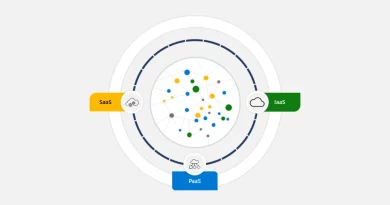5 ways a CNAPP can strengthen your multicloud security environment
The cloud security market continues to evolve, reflecting the diligent efforts of security professionals globally. They are at the forefront of developing innovative solutions and strategies to address the sophisticated tactics of cyberattackers. The necessity for these solutions to stay ahead of potential exploitation methods is clear. One notable advancement in this ongoing effort is the emergence of the cloud-native application protection platform, or CNAPP. In Microsoft’s guide “From plan to deployment: implementing a cloud-native application protection platform (CNAPP) strategy,” we explore all the aspects of this emerging trend, what it can mean for your organization, and how to get started.
CNAPP combines several cybersecurity capabilities—cloud security posture management (CSPM), cloud infrastructure entitlement management (CIEM), and cloud workload protection (CWP), among others—into one platform. This platform protects your organization through every operation, from concept development to runtime use. And it’s tailored to applications native to a multicloud environment. As a result, you can both ensure management access and strengthen app-related defenses against potential vulnerabilities in multicloud setups.
Choosing CNAPP as your solution can help chief information security officers (CISOs) build impact.1 When weighing the value of CNAPP, consider these numbers:
- 40% of organizations used a CNAPP in 2023 and an additional 45% expect to use one by the end of 2024.2
- 87% of organizations embrace multicloud.3
- 82% of breaches involved data stored in the cloud.4
- $4.45 million is the average cost of a data breach.5
- 54% of organizations do not include security in the development phase.6
Read on for five of the biggest insights found in the guide and download “From plan to deployment: implementing a cloud-native application protection platform (CNAPP) strategy” to dive deeper into this important subject. Use it as a valuable resource to guide your CNAPP planning.

Implementing a CNAPP strategy
Learn how a cloud-native application protection platform can strengthen your organization’s security strategy.
Insight #1: AI can tighten security and deliver insights
AI and machine learning play key roles in threat mitigation and security operations for cloud security. In fact, they could even be considered the backbone of these strategies because they give you the ability to analyze and respond to threats in real-time. Seconds matter in cybersecurity and could be the difference between minimal and major damage from a cyberattack.
AI and machine learning can also provide an assist by increasing predictive analysis and automating security tasks, helping your employees prioritize strategic security tasks. Manually managing today’s complex cloud infrastructures simply isn’t possible. The key is to include human oversight with human-in-the-loop monitoring of the technologies.
Insight #2: CNAPP can address challenges like alert overload and more
CNAPP holds day-to-day ease for security teams and strategic value for decision-makers. And there’s an urgent need for an end-to-end platform for cloud security—even better if powered by AI and machine learning. CNAPP helps you address some of the biggest challenges in cloud security, including:
- Building security into software during development: Security as code, which involves building security into software during development, will keep gaining momentum. CNAPP benefits the development process in several ways, including ensuring security is part of application development and forging collaboration between the developers and security teams.
- Improving multicloud security posture: With CNAPP solutions, you can get an aggregation and analysis of data from multiple cloud platforms and services in a unified dashboard. These centralized insights can help security teams prioritize tasks more easily. Expanding multicloud visibility and enhancing multiplatform protection are two advantages of recent Microsoft Security innovations.
- Decreasing costs and tackling advanced cyberthreats: Security operations center (SOC) analysts and security admins could be easily overwhelmed by the modern digital threat landscape and frustrated by the number of signals. The predictive analytics of CNAPP solutions can make it easier for them to identify and mitigate potential risks while automating security responses to threats.
Insight #3: Effective cybersecurity takes a good partner
The next wave of multicloud security with Microsoft Defender for Cloud
Keeping user needs in mind, Microsoft has its own CNAPP solution—Microsoft Defender for Cloud. This comprehensive security solution has robust security features to safeguard a wide array of resources, including servers, containers, databases, applications, and, crucially, data storage solutions like Microsoft Azure Storage, across various cloud platforms. Implementing Microsoft Defender for Cloud can protect against current threats and position your organization to confidently address emerging security threats in the cloud.
Cybersecurity is a dual effort between cloud service providers and users. Microsoft Defender for Cloud models this collaborative approach with a more integrated and proactive strategy than is common with traditional security. Among other attributes, it aligns with DevOps, features rapid deployment capabilities, and offers two levels of CSPM functionality—foundational and premium from an offering called Microsoft Defender Cloud Security Posture Management. Deploying CSPM services should be a part of your CNAPP strategy.
It also integrates with other cybersecurity solutions. But given the way Microsoft embraces innovation, it’s probably no surprise that we’ll continue to evolve this solution to keep pace with fluid technological advancement. So, as usual, watch this space for exciting announcements to come.
Insight #4: Operationalizing CNAPP is a multipronged approach
With any solution, the benefits can’t be realized if your users aren’t adopting it. Operationalizing Microsoft Defender for Cloud takes both integrating it into daily operations and satisfying your users’ needs by continuously evolving cloud security. You want your users to manage it and use the platform’s capabilities. This includes its functionalities across Microsoft Azure, Amazon Web Services, and Google Cloud Platform.
Other factors of operationalizing CNAPP include:
- Monitoring continuously, evaluating risk, and assessing status.
- Managing identity entitlement.
- Training employees to use security tools.
- Setting processes in place that can mitigate and remediate unhealthy resources.
- Fostering a culture of security awareness.
Insight #5: CNAPP is a critical part of a modern SOC
The SOC is critical and you strive for it to be efficient and effective. The insights from a CNAPP like Microsoft Defender for Cloud can dramatically transform SOC operations due to its total visibility, real-time monitoring, compliance and risk management tools, multiple integrations, and advanced analytics.
You can take a more proactive, strategic approach to cloud security with capabilities like:
- Detailed insights into threats and vulnerabilities, including their possible severity and impact.
- Automated compliance assessments based on industry standards.
- Post-incident analysis support through incident information.
Strengthening the SOC even further is a new Microsoft Defender for Cloud integration with Microsoft Defender XDR. You gain access to Defender for Cloud alerts and incidents within the Microsoft Defender portal for richer investigation context.
These highlights are just the beginning of what you can accomplish with CNAPP.
Explore the future of CNAPP and cloud security
Building a secure-first organization is critical to counter the continual stream of cyberthreats and the increasingly sophisticated nature of them. The future holds significant promise for CNAPP, and Microsoft is leading in this effort with solutions like Microsoft Defender for Cloud. Get details on CNAPP use case scenarios and Defender for Cloud’s integrations with other Microsoft products—and strategies for adopting and operationalizing it—in our guide “From plan to deployment: implementing a cloud-native application protection platform (CNAPP) strategy.” Or, watch our podcast for an expert discussion on how CNAPP helps you address modern challenges. Learn more about how Defender for Cloud can help you protect your multicloud resources, workloads, and apps.
Learn more
To learn more about Microsoft Security solutions, visit our website. Bookmark the Security blog to keep up with our expert coverage on security matters. Also, follow us on LinkedIn (Microsoft Security) and X (@MSFTSecurity) for the latest news and updates on cybersecurity.
1Want to build impact as a CISO? Choose CNAPP as your solution, CSO. May 26, 2024.
2The future of cloud security: Top trends to watch in 2024, InfoWorld. March 14, 2024.
32023 State of the Cloud Report, Flexera.
4Microsoft Enterprise DevOps Report.
5Cost of a Data Breach Report, IBM. 2023.
6Microsoft Cloud Security Priorities and Practices Research.
READ MORE HERE


